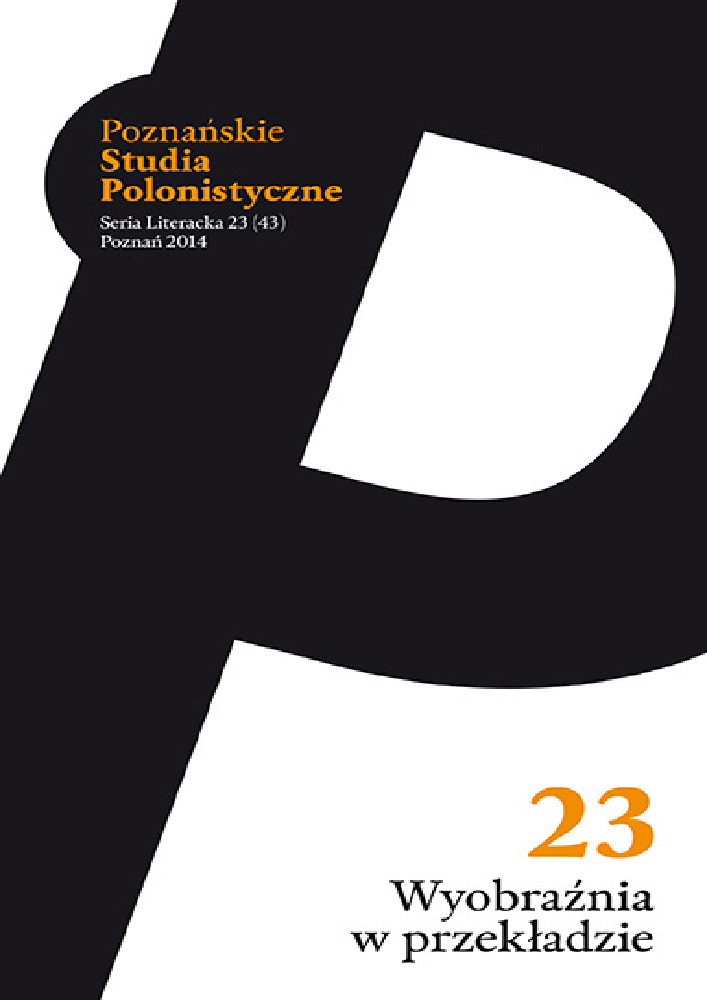Abstract
One of the most frequent problems in translation is the question of translation of hypocorisms: inasmuch as Polish is rich in diminutives, English practically does not have them. Diminutive and affectionate forms in a very limited range of contexts, and descriptive (analytical) diminutives are of little stylistic interest. The article discusses examples of coping with this problem in translations both from Polish into English, and from English into Polish. The authors tries to answer the question if it is possible to retain the emotionality expressed in diminutives of a translated text. Two texts were selected for the analysis: Jan Kochanowski’s Laments in Stanisław Barańczak and Seamus Heaney’s translation, and Ronal Fairbank’s The Flower Beneath the Foot, translated by Andrzej Sosnowski. Laments, addressed to a dead child, are of particular interest for the analysis, because diminutives and terms of endearment are frequently used and perform a peculiar function of creation of meaning. Discussing this translation, the author of the article tries to demonstrate that the emotionality expressed by Kochanowski through hypocorisms has been expressed by other means in the English translation: the right choice of epithets, and orchestration of the verse. In the Polish translation of Firbank’s novel, the hypocorisms introduced by the translator are read not as an arbitrary addition, but as elements that contribute to the camp climate of the novel, and reflect the irony, artificiality, and theatricality of the work, by means that are accessible in Polish language.References
Bartmiński J., Zdrobnienia i spieszczenia, w: idem, O języku folkloru, Wrocław 1973.
Firbank R., Five Novels, New York 1981.
Firbank R., Zdeptany kwiatuszek, tłum. A. Sosnowski, Warszawa 1998.
Jespersen O., Growth and Structure of the English Language, Oxford 1948.
Kochanowski J., Laments, tłum. S. Heaney, S. Barańczak, Londyn 1995.
Kochanowski J., Treny, tłum. A. Czerniawski, Katowice 1996.
Kochanowski J., Treny. Laments, tłum. M.J. Mikoś, Warszawa 1995.
Kultura [hasło], w: Mały słownik antropologiczny, red. T. Bielicki, Warszawa 1976.
Miłość jest permanentną rewolucją – zapis debaty, „Wakat” 2011, nr 15 (wersja internetowa – http://www.sdk.pl/wakat/nr 15/dyskusja.html, dostęp: 4 maja 2014).
Nichol M., 50 Diminutive Suffixes (and a Cute Little Prefix), www.dailywritingtips.com, dostęp: 4 maja 2014.
Okulska I., Miłość a fetysz a spotkanie języków. W związku z Ronaldem Firbankiem,
w: Wiersze na głos. Szkice o twórczości Andrzeja Sosnowskiego, red. P. Śliwiński, Poznań 2010.
Sarnowski M., Deminutywum jako znak ironii, w: Język a kultura, t. 3: Wartości w języku i tekście, red. J. Puzynina, J. Anusiewicz, Wrocław 1991.
License
Authors
Authors of texts accepted for publication in „Poznańskie Studia Polonistyczne. Seria Literacka” are required to complete, sign and return to the editor's office the Agreement for granting a royalty-free license to works with a commitment to grant a CC sub-license.
Under the agreement, the authors of texts published in „Poznańskie Studia Polonistyczne. Seria Literacka” grant the Adam Mickiewicz University in Poznań a non-exclusive, royalty-free license and authorize the use of Attribution-NoDerivatives 4.0 International (CC BY-ND 4.0)Creative Commons sub-license.
The authors retain the right to continue the free disposal of the work.
Users
Interested Internet users are entitled to use works published in „Poznańskie Studia Polonistyczne. Seria Literacka” since 2016, for non-commercial purposes only, under the following conditions:
- attribution - obligation to provide, together with the distributed work, information about the authorship, title, source (link to the original work, DOI) and the license itself.
- no derivatives - the work must be preserved in its original form, without the author's consent it is not possible to distribute the modified work, such as translations, publications, etc.
Copyrights are reserved for all texts published before 2016.
Miscellaneous
Adam Mickiewicz University in Poznań retains the right to magazines as a whole (layout, graphic form, title, cover design, logo etc.).
